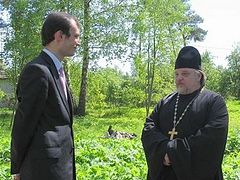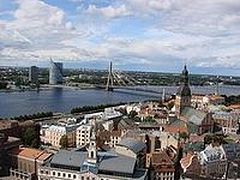Opolie, Latvia, July 5, 2018
“God is not mocked,” and the men who destroyed the previous chapel soon became seriously ill and died.
A new Orthodox chapel dedicated to the Nativity of the Most Holy Theotokos is being built on the site of a healing spring in the village of Opolie in central Latvia.
A moleben with the laying of the first stone was served on July 1 by local dean Archpriest Viktor Teplov and a number of other priests, with the participation of the local faithful and guests from surrounding villages and parishes, the website of the Latvian Orthodox Church reports.
Everyone was invited to join in a meal together following the service.
***
According to tradition, the spring was discovered by a local, deeply-believing man who was blind from birth, and constantly prayed to God and the Mother of God for healing, that he might see the wonders of God’s creation. The Mother of God eventually appeared to him in a dream and pointed him to the holy spring, where he went and washed his eyes and miraculously gained his sight.
Finding the site of the spring in poor condition in 1937, the local priest and faithful decided to erect a chapel. The Divine Liturgy was celebrated that year on the feast of the Nativity of the Theotokos in a nearby parish, after which the first procession to the newly-built chapel was held, with more than 1,000 people making the three-mile journey.
In the 1960s, the chairman of the local collective farm decided to demolish the chapel. The locals were strongly against this, knowing the healing properties of the spring, but none dared to speak out against the decision, given the harshness of the Khrushchev-era persecutions, and the chairman, V. N. Stepanov, ordered that the chapel be pulled into the swamp by a tractor.
But “God is not mocked,” writes the Latvian Church site, and Stepanov and the tractor driver soon became seriously ill and died.
In the summer of 1991, after Latvia declared its independence, a new chapel was built on the site of the healing spring, with the assistance of the local bishop and the Deputy Minister of Agriculture. The first procession with a moleben for the blessing of waters took place on September 21, 1991.
Processions resumed again in 2000, taking place every year on September 20. Many believers also go to the spring throughout the year to collect holy water and pray for healing. Since 2006, there has been a weekly moleben for the blessing of waters with an akathist served at the chapel. The people began to notice that no one would get wet during the service—it would rain only before or after the prayers.
Now work is underway to build a new chapel, where the faithful can not only collect holy water, but also immerse themselves in the holy spring, for the healing of soul and body.
Follow us on Facebook!





